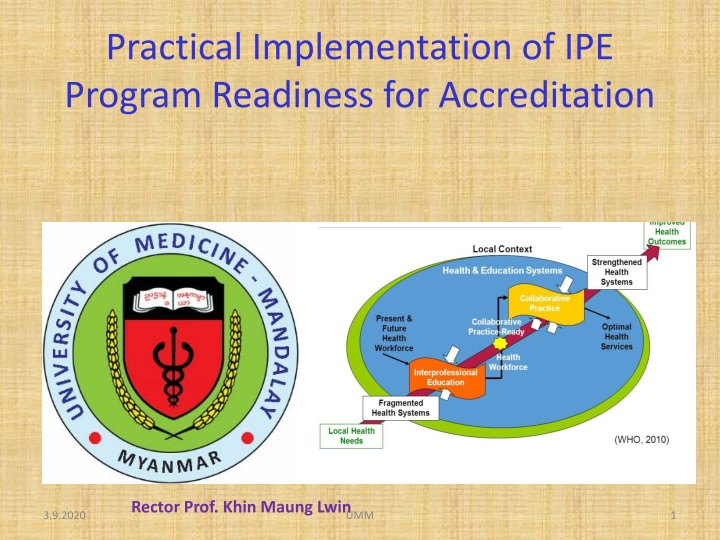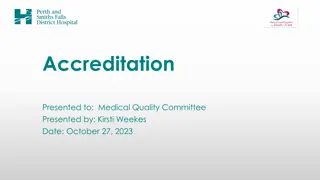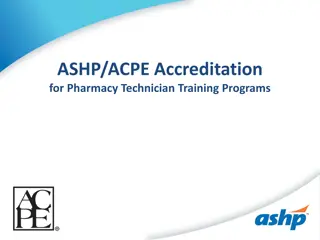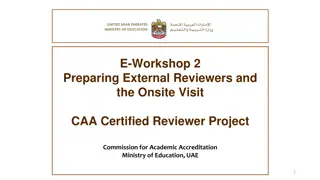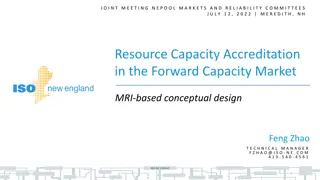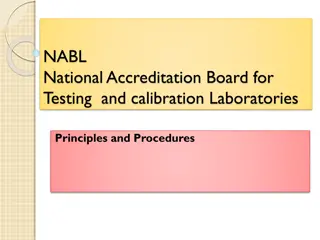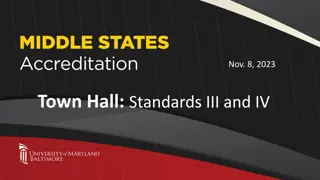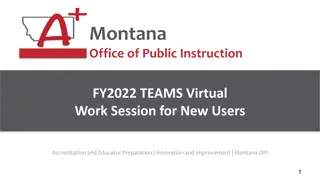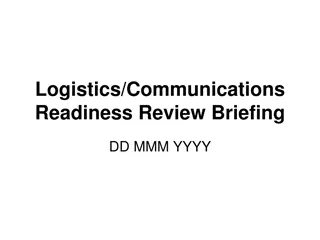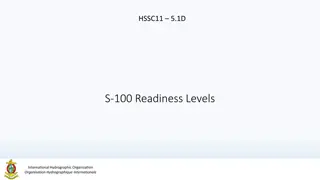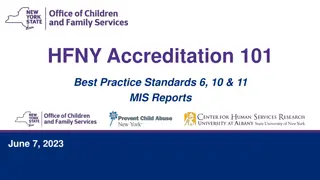Practical Implementation of IPE Program Readiness for Accreditation
For successful implementation of an Interprofessional Education (IPE) program, forming an IPE committee is crucial for coordination and collaboration among faculty, administrators, and leaders from various professions. The committee plays a key role in deciding goals, outcomes, credit points, and hours for the program. Designing the curriculum and establishing a mission statement are essential steps in implementing IPE effectively. Caution should be exercised to avoid over-assessment of the program and participants.
Download Presentation

Please find below an Image/Link to download the presentation.
The content on the website is provided AS IS for your information and personal use only. It may not be sold, licensed, or shared on other websites without obtaining consent from the author.If you encounter any issues during the download, it is possible that the publisher has removed the file from their server.
You are allowed to download the files provided on this website for personal or commercial use, subject to the condition that they are used lawfully. All files are the property of their respective owners.
The content on the website is provided AS IS for your information and personal use only. It may not be sold, licensed, or shared on other websites without obtaining consent from the author.
E N D
Presentation Transcript
Practical Implementation of IPE Program Readiness for Accreditation Rector Prof. Khin Maung Lwin 3.9.2020 UMM 1
Practical Implementation of IPE in Myanmar Health Context Introduction: For successful implementation of IPE program it is imperative to form an IPE committee for co- ordination and collaboration between faculty, administrators and leaders of different professions who will be participating in the IPE program. 3.9.2020 UMM 2
IPE Curriculum Committee The IPE committee is the main body for successful implementation of IPE program. The IPE curriculum committee should consist of members representing all health care professions participating in the program. 3.9.2020 UMM 3
This committee should decide on goals, mission, outcomes of the IPE curriculum, credit points for IPE program in each year longitudinally, and hours for IPE after mapping out the teaching/learning schedules 3.9.2020 UMM 4
Designing Curriculum and Steps for Implementing IPE Curriculum
Design the IPE curriculum Establish a mission, goals and outcome statement for IPE Find a common philosophy (The underlying motivation for implementing IPE may be different for individual pro-grams) 3.9.2020 UMM 6
Defining which professions will participate Reviewing each program s curriculum is time well-spent Students in different health professional programs develop clinical competency and professional identity at different rates 3.9.2020 UMM 7
Assessment Planning Caution for over assessment of IPE program: Over assessment of IPE programs and participants should be avoided. 3.9.2020 UMM 8
Designing Assessment Map Institutions should strive to develop an overall assessment map of their IPE programs to evaluate which IPE competencies 3.9.2020 UMM 9
Accreditation The action or process of officially recognizing someone as having a particular status or being qualified to perform a particular activity The Goal of Accreditation is to ensure that institutions of higher education meet acceptable levels of quality. 3.9.2020 UMM 10
Criteria Checklist for Accreditation(Basic Medical Education) Standard Area 1: Vision, Mission and Outcome Standard Area 2: Educational Program and Principles Standard Area 3: Assessment of Students 3.9.2020 UMM 11
Standard Area 4 : Students Standard Area 5: Academic Staff/Faculty Standard Area 6: Education Resources 3.9.2020 UMM 12
Standard Area 7 : Programme Evaluation Standard Area 8 : Governance and Standard Area 9 : Continuous Renewal Administration 3.9.2020 UMM 13
University of Medicine, Mandalay Vision To be an internationally recognized as an academic institution in medical education of excellence in medical education, research and health services 3.9.2020 UMM 14
Mission Education - to produce competent doctors and effective educators Research - to further research culture and to foster innovation through collaboration with national and international institutions Health Service - to serve the community through a patient-centered curriculum instilling cultural competence and to provide community-oriented comprehensive healthcare 3.9.2020 UMM 15
OUTCOMES OF THE BASIC MEDICAL PROGRAM To produce competent doctors through a community-oriented, patient-centered curriculum that prepares graduates to become lifelong learners To develop research culture and to foster innovation through collaboration with national and international institutions To serve the community through its compassionate and culturally competent graduates providing comprehensive healthcare 3.9.2020 UMM 16
Outcome Based Integrated Curriculum Framework(December 2019 to December 2026)MBBS Course (Total 7 years) 3.9.2020 UMM 17
Year Semester 1 Horizontal Modules Semester 2 Horizontal Modules Vertical Modules Foundation Year(one year) Foundation for Sciences Foundation for Medicine Personal Professio Develop ment nal & Year 1(one year) System Modules Integrated basic medical sciences with clinical relevance Year 2 (one year) System Modules Integrated basic medical sciences with clinical relevance 4.Community and Family Health Year 3(one year) Junior Clerkship- Core Clinical Medicine in practice 2.Medical Ethics & Professional 5.Social &Behavioral Science 3.Research Culture and skills Year 4 (one year) Specially Clerkship-Specialities in all ages of medicine 1.Clinical Management Year 5 (one year) Senior Clerkship- Student intern program(Rotation in four main clinical disciplines) Intenship(one year) 3.9.2020 House Officer Training UMM 18
IPE Interprofessional education is a collaborative approach to develop healthcare students as future inter-professional team members in inter-professional teams as future healthcare providers. These teams will work collaboratively on complex medical conditions resulting in improved healthcare outcomes for patients. 3.9.2020 UMM 19
IPCP It creates an interprofessional team designed to work on common goals to improve patient outcomes Didactic program Community based experience Inter-professional simulation experience or Service learning component 3.9.2020 UMM 20
For Standard Area 1.1 Our Institute (UMM) has well defined Vision And Mission Provide the Mission aims and educational strategy by Personal & Professional Development at foundation year as vertical modules At five medical years, provide the Mission by learning strategy of Medical Ethics, Professional and Communication Skill 3.9.2020 UMM 21
For Standard Area 1.3 To produce competent doctors for comprehensive healthcare services, provide the Learning outcomes for each academic level (year/module/course) by adding vertical modules 3.9.2020 UMM 22
For Standard Area 2 Educational Programme and Principles The Medical Institution must define the over Curriculum Based on outcomes, disciplines, organ system, clinical problems/tasks, disease pattern or modular / spiral design 3.9.2020 UMM 23
For Standard Area 2.1.6 Must incorporate Institutional/learning methods that stitumulate, prepare and support to take Role & Responsibility (IPE:Domain 2) for their learning process and prepare the students to have lifelong learning To facilitate the learning that is enjoyable, interesting and motivating 3.9.2020 UMM 24
For Standard Area 2.4.1 The Curriculum must incorporate from early year, expected outcomes related to the needs of society, healthcare system, changing demographic patterns and cultural context Should be learning strategies communicate with ethical principles and adherence to medical law and that nurture professional conduct with patients, families and others involved in care of the patients 3.9.2020 UMM 25
For Standard Area 2.5.2 Increasing the responsibilities (IPE : Domain 2) for the patients care should be exercised under supervision as the students progresses through the programme Should ensure horizontal integration of associated science as well as vertical integration of lifelong learning(Area 2.6.5) 3.9.2020 UMM 26
For Standard Area 3(Assessment of the Students) Must ensure that clinical skills assessment as a significant component of overall assessment Have mastered specific component skill including history taking, Physical Examination, communication skill(IPE: Domain 3), Diagnosis and Management(3.1.4) 3.9.2020 UMM 27
Attitude & professionalism should be judged by systematic observation and recording of performance , attitudes and professional behavior using valid and reliable assessment tools ( Standard Area 3.1.8) 3.9.2020 UMM 28
For Standard Area 7(Programme Evaluation) Must have integrated institutional responsibility for the design, implementation and monitoring of the school curriculum(7.1) Must ensure that the result of program evaluations meet the expected institutional outcomes (7.5) 3.9.2020 UMM 29
For Standard Area 9(Continuous Renewal) Initiating procedures for regularly reviewing and updating its structure and function (with regard to the structure, processes, content, outcomes/competencies, assessment and learning environment of the program (9.1.1) 3.9.2020 UMM 30
Should develop assessment principles, assessment method and the numbers of examination according to changes in intended educational outcomes (9.8) Should refine the process of programme mornitoring and evaluation (9.12) 3.9.2020 UMM 31
Example of Integrated Assessment Map for Core Competencies for Four Years(IPE,Draft) Year Assessment of core competency IPE Activities Assessment Method Rubric Year 1 1.Ethics & Shared Value -Individual presentation -Group Presentation Individual Participation Score, Group Interaction ratings Individual participation 30%, Group Delivery 40% Facilitator Observation 30% 2.9.2020 Rector Prof. Khin Maung Lwin (UMM) 35
Example of Integrated Assessment Map for Core Competencies for Four Years(IPE,Draft) Year Assessment of core competency IPE Activities Assessment Methods Rubric Year 1 2. Role & Responsibilities Group Presentation on Local Health Needs ePoster Presentation, Group Presentation Individual participation 30%, Group Delivery 40% Facilitator Observation 30% 2.9.2020 Rector Prof. Khin Maung Lwin (UMM) 36
Example of Integrated Assessment Map for Core Competencies for Four Years(IPE,Draft) Year Assessment of core competency IPE Activities Assessment Methods Rubric Year 1 3. Teams work & Leadership Group Presentation on Local Health Needs ePoster Presentation, Group Presentation Individual participation 30%, Group Delivery 40% Facilitator Observation 30% 2.9.2020 Rector Prof. Khin Maung Lwin (UMM) 37
Example of Integrated Assessment Map for Core Competencies for Four Years(IPE,Draft) Year of Course Assessment of core competency IPE Activities Assessment Method Rubric Year 1 4. Communicatio n Skill Group Discussion -Individual Participation, Presentation -ICCAS Interprofessional Collaborative Competency Attainment Survery Peer Assessment 40%, Facilitator s Assessment 40% Self Perception 20% 2.9.2020 Rector Prof. Khin Maung Lwin (UMM) 38
Conclusion IPE & IPCP program should be institutionalized with considerable energy in Myanmar to be able to actually result in good health outcomes with patient centered care 3.9.2020 UMM 39
Thank You Rector Prof. Khin Maung Lwin 3.9.2020 UMM 40
